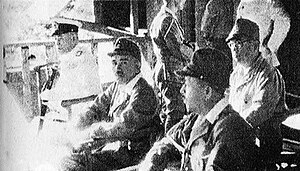| Operation I-Go | |||||||
|---|---|---|---|---|---|---|---|
| Part of the Pacific Theater of World War II | |||||||
 Isoroku Yamamoto (far left) and Jinichi Kusaka (center left) supervise air operations from Rabaul during Operation I-Go in April 1943 | |||||||
| |||||||
| Belligerents | |||||||
|
Allied forces including: |
| ||||||
| Commanders and leaders | |||||||
|
|
| ||||||
| Strength | |||||||
| 350 aircraft[1] | |||||||
| Casualties and losses | |||||||
|
1 destroyer, 1 tanker, 2 transports, 1 corvette sunk, 25 aircraft destroyed[2] | 55 aircraft destroyed[3] | ||||||
Operation I-Go (い号作戦, I-Go sakusen) was an aerial counter-offensive launched by Imperial Japanese forces against Allied forces during the Solomon Islands and New Guinea campaigns in the Pacific Theater of World War II. Taking place from 1–16 April 1943, Japanese aircraft—primarily from Imperial Japanese Navy units under the command of Admirals Isoroku Yamamoto and Jinichi Kusaka—attacked Allied ships, aircraft, and land installations in the southeast Solomon Islands and New Guinea. The goal of the operation was to halt the Allied offensives to give Japan time to prepare a new set of defenses in response to recent defeats in the Guadalcanal campaign and in New Guinea at Buna–Gona, Wau, and the Bismarck Sea.
The operation consisted of several massed aerial attacks by Japanese bomber and fighter aircraft—based at Rabaul, Bougainville, and the Shortland Islands—against Allied targets on and around Guadalcanal and the Russell Islands in the Solomons and Port Moresby, Oro Bay, and Milne Bay in New Guinea. Although the Japanese sank several Allied transports and warships, the attack failed to inflict serious damage. Based on inaccurate and unintentionally exaggerated reports from the involved aircrews, Yamamoto halted the attacks on 16 April, believing the operation to be a success. The operation did not significantly delay Allied preparations for further offensives in the South Pacific. Yamamoto was killed shortly thereafter while traveling to congratulate units that had participated in the operation.